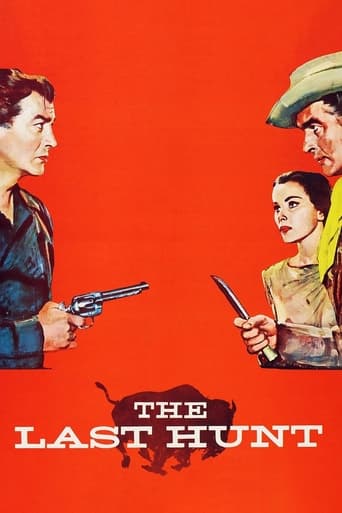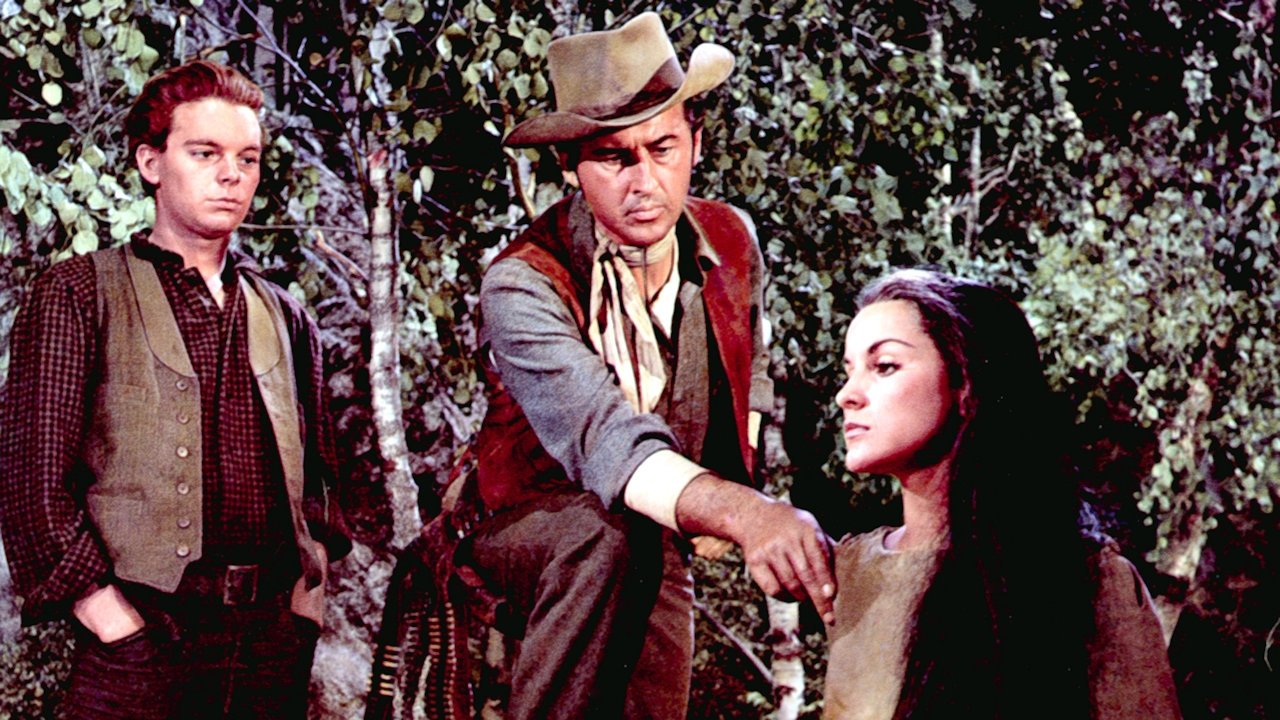JohnHowardReid
NOTES: Locations in Custer State Park in South Dakota and the United States National Monument at Badlands. The producers express their deep appreciation to the officials and to Governor Joe Foss of South Dakota.COMMENT: A grim and unsavory tale which, though well acted, is often horrifying to watch. Taylor gives his best performance ever as the sadistic bad guy. Lloyd Nolan makes the most of his dramatic opportunities too, but the unusually colorless Stewart Granger is poorly treated by Richard Brooks in both his capacities as writer and director, aside from one good scene in which he stymies Constance Ford's saloon girl, manhandles Fred Graham's barman and generally takes on all comers at the Golden Ace saloon (or whatever it is).Debra Paget makes a rather subdued Indian widow, while Russ Tamblyn does what he can with the somewhat unrewarding role of the conventional juvenile. But it's Taylor's film and he doesn't let anyone — not even the scenery or the buffaloes — forget it!
tomsview
"The Last Hunt" has a pretty dark story; it isn't a run of the mill western that's for sure. It's surprising that so much actually got past the 1956 censors.After losing his herd of cattle, ex-buffalo hunter Sandy McKenzie (Stewart Granger) reluctantly agrees to team up for one last buffalo hunt with Charlie Gilson (Robert Taylor), a gunfighter and man of few scruples. They are joined by a part Indian youth, Jimmy (Russ Tamblyn), and an old, one-legged skinner named Woodfoot (Lloyd Nolan), who foretells doom for those hunting the buffalo.When Indians steal their horses, Charlie hunts them down, sparing only the life of a woman and a baby. The woman (Debra Paget) is known simply as the Indian Girl throughout the movie. Taylor has only one thing in mind for her; a bit of stress release after a full day's hunting – mind you, this is a mid-fifties MGM movie.The buffalo hunt produces a wealth of hides, but Sandy and Charlie fall out over the treatment of the woman. Sandy tries to protect her, but Charlie does not take kindly to losing his prize of war. The finale produces one of those memorable screen moments as Charlie relentlessly pursues Sandy and the woman.The film's grittiness is down to Richard Brooks. A writer as well as a director, he usually wrote his own screenplays including this one from Milton Lott's novel. He was the complete storyteller, much like John Huston who had actually been a mentor earlier in Brooks' film career. A difficult man, he was also tough – he was reputed to have sat the formidable Burt Lancaster on his backside during a heated dispute.It was Brooks' idea to film an actual cull of one of the few surviving buffalo herds and incorporate it into the movie – a lot of people didn't like it including Stewart Granger, who thought Brooks revelled in the carnage a little too much.Robert Taylor gives the standout performance in the film. Referred to as 'beautiful Robert Taylor' in movies before the war, as he aged, his features hardened, although still handsome, he developed a slightly roguish look, which suited his role in this film perfectly. Charlie believes killing is the only emotion that makes him feel alive. It could have been a one-dimensional performance, but Taylor gives the character bi-polar highs and lows, making Charlie seem even more dangerous."The Last Hunt" was overshadowed by another western released in 1956, which also explored the themes of hatred and relentless pursuit, John Ford's "The Searchers". However, any film of Richard Brooks is worth a look and "The Last Hunt" is anything but a traditional western.
Wayne Dear
The Last Hunt is the forgotten Hollywood classic western. The theme of genocide via buffalo slaughter is present in other films but never so savagely. Robert Taylor's against-type role as the possessed buffalo and Indian killer is his finest performance.In the 1950s, your mom dropped you and your friends off at the Saterday matinée, usually featuring a western or comedy. But it was wrong then and now to let a youngster watch psycho-dramas like The Searchers and The Last Hunt. Let the kids wait a few years before exposing them to films with repressed sexual sadism and intense racial hatred.Why did Mom fail to censor these films? Because they featured "safe" Hollywood stars like Taylor and John Wayne. But the climatic scene in The Last Hunt is as horrifying as Vincent Price's mutation in The Fly.The mythology of the white buffalo, part of the texture of this movie, was later ripped-off by other movies including The White Buffalo, starring Charles Bronson as Wild Bill Hickock. The laugh here is that Bronson used to play Indians.Today a large remnant bison herd resides in Yellowstone National Park in Wyoming. In the winter, hunger forces surplus animals out of the park into Montana, where they are sometimes harvested by Idaho's Nez Perce Indians under a US treaty right that pre-dates the Lincoln Presidency. Linclon signed the Congressional act which authorized the continental railroad and started the buffalo slaughter.
MartinHafer
This movie is a real mixed bag. In some ways, it's quite intelligent and moving but in other ways the film really misses the mark and could have used a re-write.First, I admire that the film deals with the senseless slaughter of millions of buffalo in the 19th century. This was such a waste and was a topic worthy of making a film about--but the filmmakers also gave a very mixed message. While the impact on the Indians (mass starvation) and waste of life was portrayed, the prologue also said that the massacre was the result of Whites AND Indians!! This is ridiculous, as the Indians killed buffalo as needed and their impact on the buffalo population was limited--playing moral equivalence was ludicrous! I am certainly no politically correct zombie, but this assertion was stupid. Additionally, many of the buffalo that were killed in the film really were being killed! As a Department of the Interior management decision to thin the remaining herds, this thinning was filmed and the animals that died in the film really did die--something that may make PETA-types cringe or become sick--so be forewarned!! Second, I liked the counter-point of having a man who is sick of the slaughter (Stewart Granger) and the blood-lust of of his partner (Robert Taylor). However, while this juxtaposition is interesting and brought the point home well, it didn't make sense when you think about it. After all, if Granger had enough of the killing, then why did he spend so much time in the film killing?! Plus, Robert Taylor's character was so over-the-top and ludicrously unbelievable that the whole partnership seemed impossible and dumb.Now there were also several things I did like about the movie. First, I was surprised how effective Stewart Granger was as a Buffalo Bill-type man. He had no trace of his native British accent and was amazingly good. Second, the very end of the film was handled deftly--how the final showdown went down was really great. Third, it was nice to once see that a typical Western cliché is absent. In this film, there is no "hooker with a heart of gold"! Instead, she's kind of ugly and mean and is purely in it for the money! Fourth, When Granger is involved in a bar fight, the song "Yellow Rose of Texas" plays during this battle and is very, very similar to the final climax in GIANT--and I think this was intentional, as both films came out in 1956.So overall, this is a mixed bag--full of great ideas but poorly executed as well. As a result, it's interesting but quite skip-able.


 AD
AD





